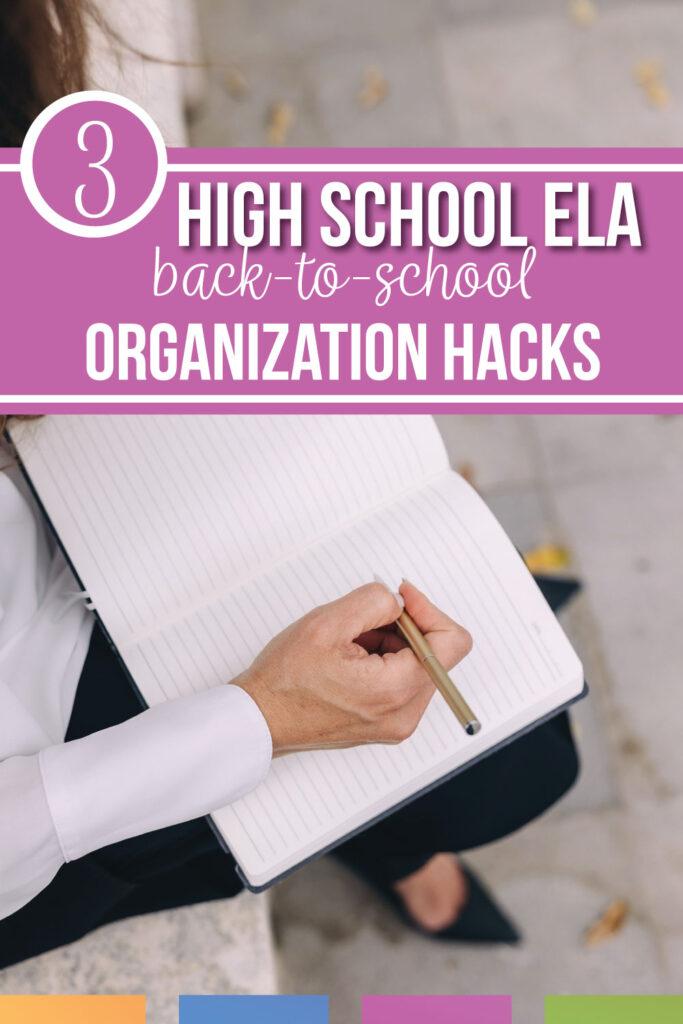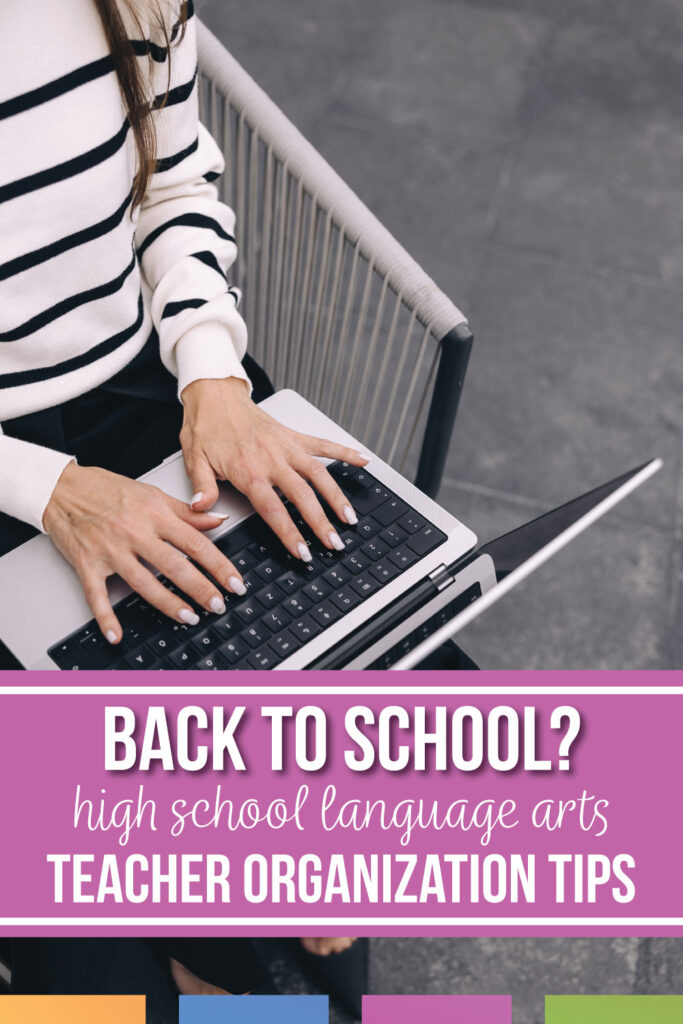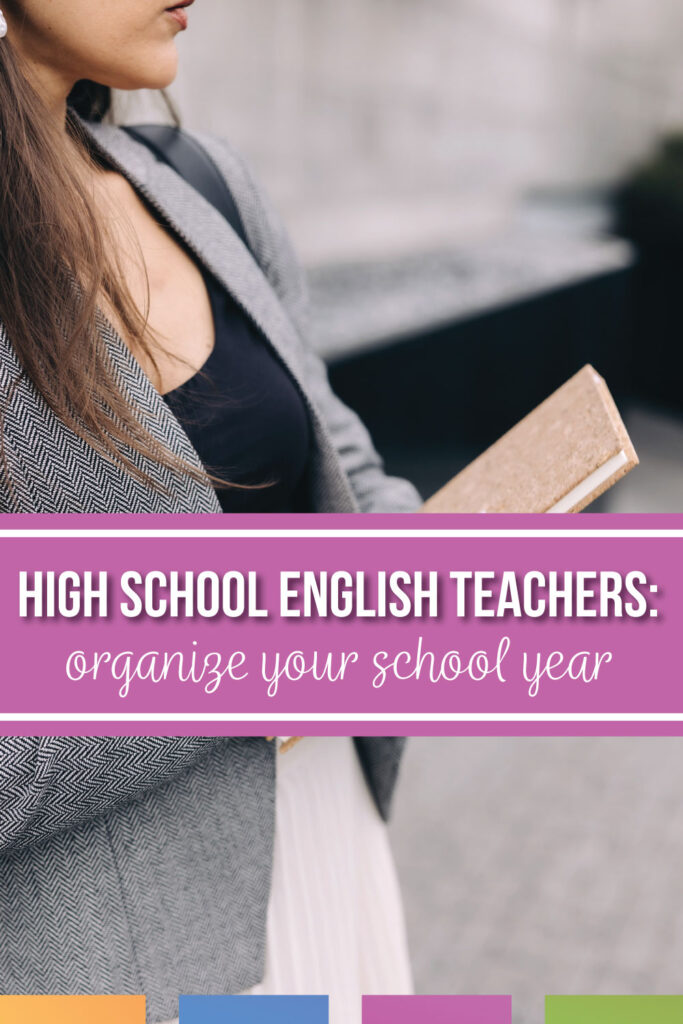Teacher organization on your mind? I have teacher organizational tools.
A little over ten years ago, I became fascinated by organization in the classroom. Teacher organization, student organization, organization techniques. I loved the topic so much that I did my research on it for my master’s degree. (Dorky, huh?) Now, I think of teacher organization tools that are both digital and physical.
People are more successful when they are organized and have organizational tools built into their habits. Since I’ve done research concerning organization, I have a unique perspective. From personal experience, I’ve never seen professionals (businesspeople, teachers, administrators) not struggle with organization.
This post specifically helps the high school teacher organization schedule before school begins. I do not spend days upon days at my classroom, and I do not heavily decorate. I would also never encourage teachers to spend time or money they don’t want to spend!
How can organization tips help me as a high school teacher?
I invest time in my classroom the week before teachers arrive. Typically, three days are sufficient (not even complete days) organizing myself, some of them contractual and some not. A division of those work days includes physical classroom, teacher organization, and student prep.
Day one: physical classroom hacks
Take with you: Head to school with dust rags, any new library books, material and ribbon for bulletin boards, and any other new supplies that you gathered over break. Pack coffee, water, or tea and a snack.
Keep in mind: Your overall color scheme and environment.
My classroom is eclectic. During the summer (all year, actually!) book-ish and writing trinkets find me. Plus, garage sales and discount stores have great used books.
All of those treasures find their way to my classroom at the start of August.
Clean bins, crates, shelves
My current room is really clean at the start of each year, so my dusting is minimal.
With other classrooms, I did more cleaning, so you might too. Wipe down shelves and desks, or maybe move crates and bins to find misplaced pieces. Your cleaning time might be nothing!
Even though I’m excited to start decorating, I force myself to wipe down the room. Don’t stick tape to a dusty surface or organize books atop spiderwebs.
Bulletin boards
After cleaning, assemble bulletin boards because they will tie colors together.
For the border, you can use ribbon, pages from an old book, or a pre-made border. Often, my bulletin boards have student work, so the boards might be blank for a few weeks. Still, the colors and messages are established. Decoration, overall, is minimal in my room.
Classroom library
My library is the focus of my room, so next, I organize my classroom library. If you plan to rotate books throughout the year, decide what to showcase first. Then, organize your books. For instance, I adhere genre-labels to shelves and match a few books with the “if you like __, try ___” posters.
Supplies
My students have open access to pencils, pens, staplers, sticky notes, index cards, and erasers. . . any school supply. Decide if your students will have open access or if you want them stored.
I place those in containers around the room. (I have lots of shelving.) If you don’t have shelves, you could perhaps use the top of a filing cabinet or a rolling cart.
Knickknacks
Finally, I access all of my knickknacks, all of my little posters and encouragements and dorky pieces that are often talking points for me and my students. Those glass pieces and mismatched baskets end up in different spots every year. Those finish the physical part of my classroom.
Normally, cleaning, setting up bulletin boards, and organizing my classroom library takes a few hours. That’s day one of high school teacher organization for August.
Day Two: teacher organization
Take with you: Any final pieces (often posters). Coffee, water, or tea and a snack.
Keep in mind: Your goals for the school year.
On day two, (not always the next day!), I spend lots of time with my laptop and the school’s main printer.
Arrive with files for posters to print, and get ready to cut and laminate. Decide if your syllabus and other first day materials will be online or printed.
Syllabus
My syllabus is simple and straight-forward. (You might ask if your school has any requirements.) Explain policies and rules, provide contact information, list the classroom rules, and briefly map out the course’s content.
Look at the syllabus, and ask a coworker to read it. The syllabus is the first official paper for students!
Rules and posters
One bulletin board has school information like calendars, bell schedules, and rules. If you need simple bulletin boards, the informative display is a go-to that will last all year!
On the walls and with other bulletin boards, I add posters. My posters cover grammar, famous quotes, and later, student work. I print on colored paper to match my room without creating overwhelm.
Binder organization
Most schools require that teachers have a binder for substitute teachers, and I clean up mine every year. Other schools have binders for emergencies (fire, tornado, and such).
At this point, my physical classroom is done. High school teacher organization is important to me and once I am done with the actual classroom, I can focus on the most important aspect: my new students.
Day Three: student prep
Take with you: Any final pieces for your room. Coffee, water, or tea and a snack. Contents for your teacher desk.
Keep in mind: Students!
Schedules change, but try to organize student information as close to the first day as possible.
Begin your initial look at IEPs and 504 Plans. Mark notes if you have questions. Sometimes, counselors and parents have emailed me at this point. Note special circumstances, like where students must sit. (Please be careful with your notations. Imagine your superintendent reading what you wrote.)
After looking at student rosters, prepare for the first day of school.
Seat assignment cards
I write names on their seat assignment cards. Before students enter the first day, I will assign seats by simply putting a card on a desk. I have a first day of school presentation that directs students to find their assigned seat.
I do not complete ice breakers or fun games on the first day. Students who are introverts, who are unsure, who are unconfident are often overwhelmed on the first day of school. The assigned seats accomplish several things:
- Establishes me as the leader.
- Gives all students a spot to belong.
- Eliminates confusion, unnecessary questions, and disagreements about spots.
- Allows me to start class on time.
- Creates a calm environment.
- Naturally places students who require a location near the teacher, at the front of the room, near an exit, and on.
After I make the seat assignment cards, I clip the rosters to a clipboard so that I have it accessible that first day when I stand near the door and greet students.
So! My biggest high school teacher organization tip: be sure you are ready for students to walk through the door.
Google Classroom or other platforms
Whatever operating school system you have, give yourself patience to understand it. You might have new teacher orientation to familiarize you with the online gradebook and other tools. Ask about how to make seating charts, sub plans, and other tricks.
Consider labeling with straightforward names, something like, “English 9 Fourth Hour” to keep the pattern with every class and make the titles parallel. Upload backgrounds or whatever template your school requires.
Next, add each of your class’ digital codes for Common Lit., No Red Ink, and on. Copy the class code for each digital tool into your platform. Doing so saves me time looking for codes with transfer students.
As you walk through this high school teacher organization, consider what will make your life easier, what will make sense in two to three months.
Parent letter
Prep a parent letter to send out by the end of the first week. Connect home at the beginning of the school year. Then at meet-the-teacher night, you’ll have already started a relationship with the adults.
These high school teacher organization ideas. . . do not include my coursework or lesson planning. Use inservice days to plan and collaborate with coworkers. In my area, teachers also have a half-day after meeting students to prep for classes. For me, for my personality, I need to organize myself and my classroom before students arrive.
I mentioned many tools that makes my life easier, and my first day of school bundle contains the seat assignment cards, syllabus, passes, parent letter, digital backgrounds, teacher binder covers, and first day presentation.
Final note on high school teacher organization
I spend a lot of time before the start of the school year to establish a sense of purpose and organization for my students. All of my back to school organization doesn’t end in September.
Sure, if a process simply is not working, let it go! However, reflect throughout the year concerning teacher organization tools. Give all of your teacher organization tools a chance to work. Sometimes routines and procedures take time to implement. That first year of teaching, especially, the layout of your secondary classroom matters less than your tools and procedures.
Since we work so hard at the start organize, be sure to give your systems a chance.
The start of school brings many overwhelming feelings. Organizing yourself will start you on a positive note. Soon you’ll be sharing high school teacher organization tips of your own.





